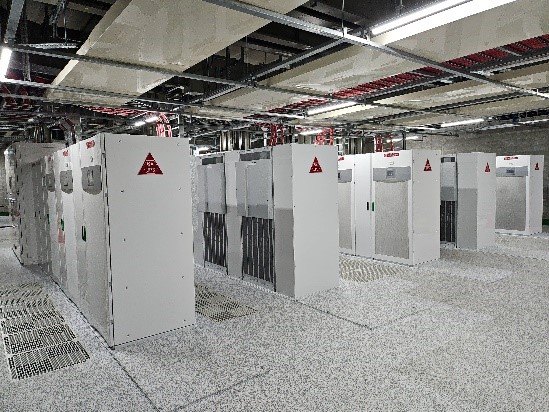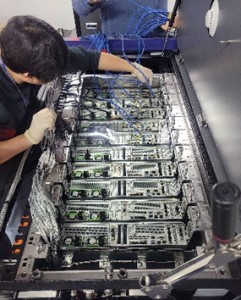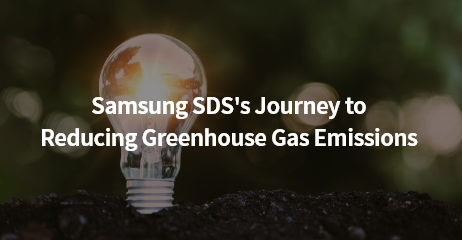The First Step Toward a Sustainable IT Services Company
Samsung SDS is actively advancing greenhouse gas reduction and renewable energy transition initiatives as part of its response to the climate crisis and commitment to sustainable management.
As part of our eco-friendly management strategy, we are accelerating the transition to renewable energy to reduce Scope 2 greenhouse gas emissions generated from electricity consumption. Over 90% of our greenhouse gas emissions stem from electricity use, making this transition a critical step in realizing sustainable management.
We are also making multifaceted efforts to reduce emissions through initiatives such as improving energy efficiency in our data centers and adopting low-emission vehicles.
Our direct Greenhouse Gas Reduction Strategy
① Deployment of High-Efficiency Equipment in Data Centers
 [UPS (Uninterruptible Power Supply) systems]
[UPS (Uninterruptible Power Supply) systems]
Samsung SDS is upgrading its operating data centers with energy-efficient systems such as open-type cooling towers and variable-type air handling units. We have also replaced key equipment like UPS (Uninterruptible Power Supply) systems with high-efficiency models. In 2023, we replaced aging UPS units at the Suwon Data Center, achieving approximately 10% energy savings. High-efficiency UPS systems were also applied to the newly established Dongtan Data Center in 2024. We aim to transition 100% of UPS systems across all facilities to high-efficiency models by 2030.
② Application of Immersion Cooling Technology in Data Centers
 [Immersion Cooling Technology]
[Immersion Cooling Technology]
Energy optimization in data centers is another essential component in reducing emissions. We are implementing immersion cooling technology to maximize the cooling efficiency of high-heat IT equipment and significantly reduce energy consumption for air conditioning.
We have conducted proof-of-concept tests for this technology and filed four domestic patents related to cooling performance and safety. Based on these results, we are applying immersion cooling technology on a pilot basis at the Dongtan Data Center and plan to expand its application in stages through 2030.
③ Transition to Low-Emission Vehicles and Elimination of Direct Carbon Emissions
 [(Left) EV charging stations / (Right) solar power generation facilities]
[(Left) EV charging stations / (Right) solar power generation facilities]
Alongside our renewable energy transition, Samsung SDS is executing strategies to directly reduce Scope 1 and Scope 2 emissions by improving energy efficiency and optimizing operational structures.
As part of this, we are converting our corporate vehicles to low-emission models. By 2024, we had introduced 18 low-emission vehicles, accounting for 12% of our total fleet, and plan to convert all vehicles by 2030.
We are also electrifying heating systems such as boilers to fundamentally reduce fuel-based greenhouse gas emissions.
Renewable Energy Goals and Procurement Plans
In 2024, Samsung SDS set a greenhouse gas reduction target of 10,902 tons and successfully offset 5,635 tons through the transition to renewable energy. We have developed an optimal renewable energy transition strategy for each country, considering factors such as energy consumption characteristics, accessibility of energy certificates, and cost efficiency.
Our target is to source 25% of our total electricity from renewable energy by 2030, supported by a phased implementation roadmap.
[Mid-to-Long Term Renewable Energy Expansion Roadmap]
| 2024 | 100% renewable energy transition at business sites in China, Europe, Vietnam, and India |
| 2025 | 100% renewable energy transition at business sites in the United States and Brazil |
| 2027 | 100% renewable energy transition across all overseas business sites |
Samsung SDS aims to transition the electricity use of all overseas business sites to 100% renewable energy by 2027, strengthening sustainable global operations. We will continue to enhance our renewable energy adoption and technology-based energy efficiency strategies to reduce emissions, build ESG trust with global customers and stakeholders, and fulfill our responsibilities as a sustainable IT services company.
